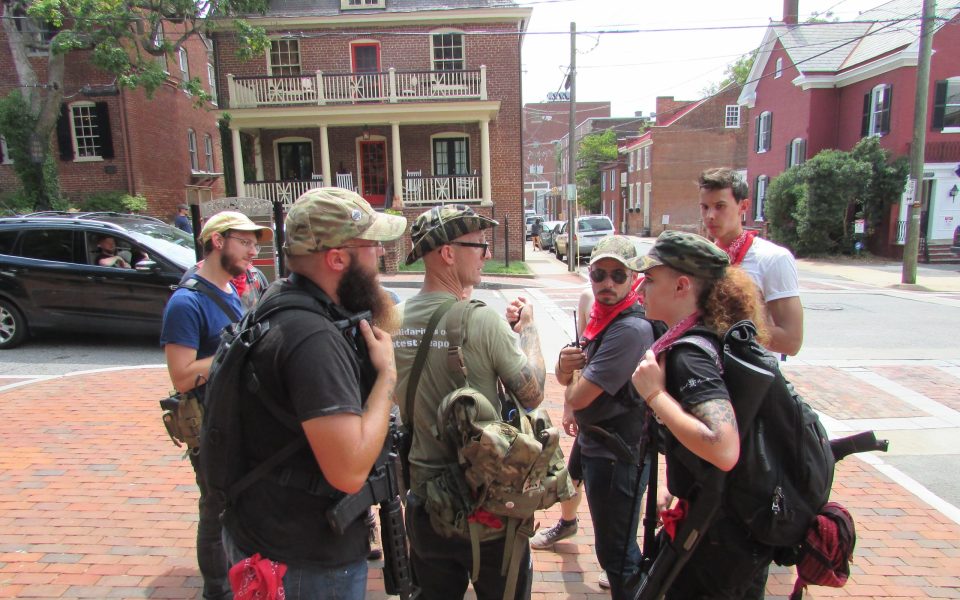The story about Redneck Revolt that we’re co-publishing this week with INDY Week changed my life. And it seemed to run into one obstacle after another. It consumed more than a year, and changed the way I see the world.
I started researching the story in March 2017 and filed a first draft in early September. After multiple revisions for two national publications, both of which pulled out, I can finally release the story I’ve carried with me like a secret companion all these months.
In hindsight, it should have been apparent why it would be such a difficult story: As a subject for journalistic documentation, far-left activists who promote firearms as a tool for deterring fascism while embracing the term “redneck” as a cultural signifier are radioactive on more than one level. Increasingly, and especially after the Las Vegas and Parkland massacres, gun control has become an article of liberal faith. Armed resistance to white supremacy, like the militant street tactics of antifa, supposedly flies in the face of the philosophy of nonviolent resistance espoused by Martin Luther King Jr., although firearms are more deeply embedded in the civil rights movement than the sanitized history of the era accounts for. Further vexing the story of Redneck Revolt, shouldn’t accounts of the struggle against white supremacy center on people of color? Either of these questions alone would be difficult to disentangle.
Like the countervailing political ascendancy of Donald Trump and rise of the alt-right, Redneck Revolt seemed to come out of nowhere. But in fact, like the ideology of white supremacy, militant resistance to fascism has been here all along. The mainstream liberal frame, which polices acceptable discourse and modes of resistance, has prevented us from seeing what’s truly happening in this country. If it wasn’t clear before, it became abundantly apparent on Nov. 8, 2016 that a tectonic shift was underway. The rupture exposed deep fault lines; the cultural forces of white nationalism, Christian radicalism and xenophobia that had been previously been dismissed as marginal were now impossible to ignore.
The real story of the 2016 election should have been apparent to me when I covered Trump’s campaign stop at Lawrence Joel Veterans Memorial Coliseum in Winston-Salem, where I spotted a man wearing a T-shirt depicting a bare-chested Vladimir Putin on horseback in the audience, and two women browbeat me with supposed evidence of a murderous body count lain at the feet of Hillary Clinton. These details were too strange and counterfactual to merit inclusion in respectable journalism, but they clearly represented a current beneath the surface that determined the outcome of the election. There are sub-rosa forces on both the far right and far left that shape events, whether we acknowledge them or not.
My journalistic interest in the culture of the far right after the 2016 election led me, paradoxically to the far left, and then pinged me back to another precinct of the far right. Specifically, I discovered Redneck Revolt when the then-fledgling Silver Valley chapter in Davidson County organized a counter-event against a Ku Klux Klan cross-burning outside of Asheboro. I was immediately intrigued: They were not a traditional civil rights organization or liberal interfaith group preaching tolerance, but rather a militant organization pledging to defend marginalized communities against white supremacist terror. And their audience, at least in part, was the disaffected working-class, rural white people who might be susceptible to recruitment by white-supremacist groups. Through my Redneck Revolt source, I learned about the patriot militia, or III Percenter, movement, about which I had previously known next to nothing.
One weekend, on April 8, 2017, I was attending an Oath Keepers Summit at Jomeokee Campground near Pilot Mountain outside of Winston-Salem. A handful of middle-aged men in military fatigues milled around a folding table holding walkie-talkies and drinking coffee at an improvised checkpoint. I followed the North Carolina commander, Lane “Gunny” Reynolds back to his campsite for an interview. Later, I heard Stewart Rhodes, the Oath Keepers’ founder and executive director expound on a voluntarist vision of community first-responder networks. Although Rhodes’ paranoid worldview — replete with tropes about black crime and disorder, and fantasies about radical Muslims as dupes of a globalist conspiracy of totalitarian domination — is deeply troubling, I found his enthusiasm for volunteer fire departments as a backbone for civil preparedness teams oddly appealing.
Flip the Oath Keepers’ preoccupation with violent gangbangers and jihadis to a more realistic threat assessment focused on white supremacists and anti-Muslim domestic terrorists, and you have a tactical response formation that looks something like Redneck Revolt.
One week later, on April 15, I was sitting with a group of anarchists in an outdoor assembly space behind a church in Denton, as Redneck Revolt planned a counter-action against the Ku Klux Klan. A revolutionary anarchist explained his interest in firearms in terms of mastering a tool similar to learning how to safely use a chemical solution to develop photographs. Something clicked for me in that moment about wanting to develop competency, to cultivate useful skills and engage in a self-generated activity that could form the basis for community.
I went home and planted a garden.

©
Join the First Amendment Society, a membership that goes directly to funding TCB‘s newsroom.
We believe that reporting can save the world.
The TCB First Amendment Society recognizes the vital role of a free, unfettered press with a bundling of local experiences designed to build community, and unique engagements with our newsroom that will help you understand, and shape, local journalism’s critical role in uplifting the people in our cities.
All revenue goes directly into the newsroom as reporters’ salaries and freelance commissions.


Leave a Reply